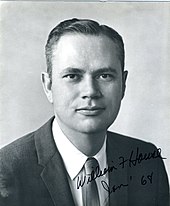William F. House
William Fouts House (born December 1, 1923 in Kansas City , Missouri , † December 7, 2012 in Aurora , Oregon ) was an American physician ( otology , surgery) and pioneer of the cochlear implant .
Life
House grew up in Whittier ( California ) and studied at the University of Southern California and at the University of California, Berkeley , where he received his doctorate in dentistry. After two years of military service in the US Navy , he also graduated from the University of Southern California with an MD degree in 1953 and a residency at Los Angeles County Hospital . At first he wanted to become an oral surgeon, but then turned to the ear, nose and throat area. He teamed up with his older brother Howard P. House (1908-2003), who founded the House Ear Institute in Los Angeles in 1946 (later the House Research Institute). House specialized in ear surgery.
At the end of the 1950s he began to experiment with electrical stimuli in the inner ear of deaf patients, which was met with great skepticism at the time - it was generally assumed that this would more likely damage the sensitive hearing. Together with the engineer Jack Urban, he developed electronic devices for stimulating the auditory nerves in the cochlea , which at that time only started at one point in the cochlea. A first attempt at transplantation in 1961 was not yet successful, but he continued the development of workable, longer-lasting, biocompatible devices with Urban, and another attempt in 1969 was more successful. In 1984 his implant was approved by the FDA and he founded All Hear Inc., which was sold to Envoy Medical Corporation in 2007. House himself performed around 3,000 cochlear implants, although for decades he encountered great opposition from professional circles and even from deaf organizations in the USA. His implant was obsolete as early as the 1980s due to the development of increasingly sophisticated devices ( Graeme Clark , Ingeborg Hochmair , Erwin Hochmair ) that used more than one channel. The 3M Company took over the license for his device, sold it in 1989 to the Cochlear Corporation, which gave up production in favor of multi-channel devices. House himself still saw a possibility of using his own device in the developing world as it was relatively inexpensive.
House himself did not make a big profit with his invention and deliberately refrained from patenting in order not to obstruct alternative developments.
He also developed surgical procedures (including operations under the microscope in the inner ear) for the treatment of Menière's disease and tumors of the auditory nerves. Among other things, he treated the astronaut Alan Shepard for Menière's disease and thus enabled his participation in the Apollo program . In gratitude, he was invited to Cape Canaveral in 1971 for the launch of Apollo 14, with which Shepard flew to the moon.
He was married to the nurse June Stendhal (died 2008) and had a son and a daughter.
Fonts
- The Struggles of a Medical Innovator: Cochlear Implants and Other Ear Surgeries , Creative Space Independent Publishing Platform, 2011, ISBN 1-4610-4637-8 (autobiography)
Web links
| personal data | |
|---|---|
| SURNAME | House, William F. |
| ALTERNATIVE NAMES | House, William Fouts |
| BRIEF DESCRIPTION | American otologist |
| DATE OF BIRTH | December 1, 1923 |
| PLACE OF BIRTH | Kansas City , Missouri |
| DATE OF DEATH | December 7, 2012 |
| Place of death | Aurora , Oregon |
